Lockheed T-33
| T-33 | |
|---|---|
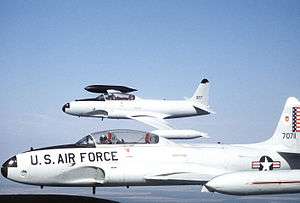 | |
| Two T-33s from the 95th Fighter Interceptor Training Squadron in flight near Tyndall AFB, Florida. The farther aircraft has been repainted and renumbered in anticipation of its delivery to the Mexican air force. | |
| Role | Training aircraft |
| Manufacturer | Lockheed |
| Designer | Clarence "Kelly" Johnson |
| First flight | 22 March 1948 |
| Status | Retired |
| Primary users | United States Air Force United States Navy Japan Air Self Defense Force German Air Force |
| Produced | 1948–1959 |
| Number built | 6,557 |
| Developed from | Lockheed P-80 Shooting Star |
| Variants | Lockheed T2V SeaStar Canadair CT-133 Silver Star |
| Developed into | Lockheed F-94 Starfire Boeing Skyfox |
The Lockheed T-33 Shooting Star (or T-Bird) is an American jet trainer aircraft. It was produced by Lockheed and made its first flight in 1948 piloted by Tony LeVier. The T-33 was developed from the Lockheed P-80/F-80 starting as TP-80C/TF-80C in development, then designated T-33A. It was used by the U.S. Navy initially as TO-2 then TV-2, and after 1962, T-33B. As of 2015, Canadian-built examples were still in-service with the Bolivian Air Force.
Design and development
The T-33 was developed from the Lockheed P-80/F-80 by lengthening the fuselage by slightly over three feet and adding a second seat, instrumentation and flight controls. It was initially designated as a variant of the P-80/F-80, the TP-80C/TF-80C.[1]
Design work for the Lockheed P-80 began in 1943 with the first flight on 8 January 1944. Following on the Bell P-59, the P-80 became the first jet fighter to enter full squadron service in the United States Army Air Forces. As more advanced jets entered service, the F-80 took on another role—training jet pilots. The two-place T-33 jet was designed for training pilots already qualified to fly propeller-driven aircraft.
Originally designated the TF-80C, the T-33 made its first flight on 22 March 1948 with U.S. production taking place from 1948 to 1959. The US Navy used the T-33 as a land-based trainer starting in 1949. It was designated the TV-2, but was redesignated the T-33B in 1962. The Navy operated some ex-USAF P-80Cs as the TO-1, changed to the TV-1 about a year later. A carrier-capable version of the P-80/T-33 family was subsequently developed by Lockheed, eventually leading to the late 1950s to 1970s T2V-1/T-1A SeaStar. The two prototype TF-80Cs were modified as prototypes for an all-weather two-seater fighter variant which became the F-94 Starfire. A total of 6,557 Shooting Stars were produced, 5,691 by Lockheed, 210 by Kawasaki and 656 by Canadair.
Operational history
U.S. Air Force and U.S. Navy
The two-place T-33 proved suitable as an advanced trainer, and it has been used for such tasks as drone director and target towing. The U.S. Air Force began phasing the T-33 out of front line pilot training duties in the Air Training Command in the early 1960s as the Cessna T-37 Tweet and Northrop T-38 Talon aircraft began replacing it under the Undergraduate Pilot Training (UPT) program. The T-33 was used to train cadets from the Air Force Academy at Peterson Field (now Peterson Air Force Base in Colorado Springs). The T-37 replaced the T-33 for Academy training in 1975. Similar replacement also occurred in the U.S. Navy with the TV-1 (also renamed T-33 in 1962) as more advanced aircraft such as the North American T-2 Buckeye and Douglas TA-4 Skyhawk II came on line. USAF and USN versions of the T-33 soldiered on into the 1970s and 1980s with USAF and USN as utility aircraft and proficiency trainers, with some of the former USN aircraft being expended as full scale aerial targets for air-to-air missile tests from naval aircraft and surface-to-air missile tests from naval vessels. Several T-33s were assigned to USAF McDonnell F-101 Voodoo, Convair F-102 Delta Dagger and Convair F-106 Delta Dart units, to include similarly equipped Air National Guard units, of the Aerospace Defense Command as proficiency trainers and practice "bogey" aircraft. Others later went to Tactical Air Command and TAC-gained Air National Guard F-106 and McDonnell-Douglas F-4 Phantom II units in a similar role until they were finally retired, with the last being an NT-33 variant retired in April 1997.
Military use by other nations
Some T-33s retained two machine guns for gunnery training, and in some countries, the T-33 was even employed as a combat aircraft: the Cuban Air Force used them during the Bay of Pigs Invasion, scoring several kills. The RT-33A version, reconnaissance aircraft produced primarily for use by foreign countries, had a camera installed in the nose and additional equipment in the rear cockpit. T-33s continued to fly as currency trainers, drone towing, combat and tactical simulation training, "hack" aircraft, electronic countermeasures and warfare training and test platforms right into the 1980s.


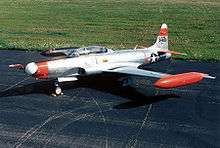
The T-33 has served with over 30 nations, and continues to operate as a trainer in smaller air forces. Canadair built 656 T-33s on licence for service in the RCAF—Canadian Forces as the CT-133 Silver Star while Kawasaki manufactured 210 in Japan. Other operators included Brazil, Turkey and Thailand which used the T-33 extensively.
In the 1980s, an attempt was made to modify and modernize the T-33 as the Boeing Skyfox, but a lack of orders led to the cancellation of the project. About 70% of the T-33's airframe was retained in the Skyfox, but it was powered by two Garrett AiResearch TFE731-3A turbofan engines.
In the late 1990s, 18 T-33 Mk-III and T-33 SF-SC from the Bolivian Air Force went to Canada to be modernized at Kelowna Flightcraft. New avionics were installed, and detailed inspection and renewal of the fuselage and wings were performed. Most of the aircraft returned in early 2001 and remain operational.
Civilian use
A limited number of T-33s have found their way into private hands and have been used by Boeing as a chase aircraft. In 2010, one of two T-33 Shooting Stars owned by Boeing was used as a chase aircraft during the maiden flight of the Boeing 787.[2] Actor and pilot Michael Dorn owned a T-33.[3] Dorn, who played the character Worf in the TV series Star Trek: The Next Generation and Star Trek: Deep Space Nine, jokingly referred to the aircraft as his 'starship'.
Variants
- TP-80C
- Original United States military designation for the Lockheed Model 580 two-seat trainer for the United States Army Air Forces. Designation changed to TF-80C on 11 June 1948 following establishment of the United States Air Force as a separate military service in 1947, and then to T-33A on 5 May 1949; 20 built.
- T-33A
- Two-seat jet trainer aircraft for the United States Air Force and delivery to foreign air forces under the Military Aid Program, 5871 including 699 diverted to the United States Navy as the TV-2.
- AT-33A
- Conversions of the T-33A for export as a close support variant fitted with underwing pylons and hard points for bombs and rockets. Also used in the original fighter lead-in program at Cannon AFB, NM approximately 1972- 1975.
- DT-33A
- This designation was given to a number of T-33As converted into drone directors.
- NT-33A
- This designation was given to a number of T-33As converted into special test aircraft.
- QT-33A
- This designation was given to number of T-33As converted into aerial target drones for the United States Navy.
- RT-33A
- T-33A modified before delivery as a single-seat reconnaissance variant; 85 built, mainly for export under the Military Aid Program.
- T-33B
- Re-designation of the United States Navy TV-2 in 1962.
- DT-33B
- Re-designation of the United States Navy TV-2D drone director in 1962.
- DT-33C
- Re-designation of the United States Navy TV-2KD target in 1962
- TO-1/TV-1
- U.S. Navy designation of P-80C, 50 transferred to USN in 1949 as jet trainers (not technically T-33 Shooting Star)
- TO-2
- United States Navy designation for 649 T-33As diverted from USAF production. Two-seat land-based jet training aircraft for the U.S. Navy. First 28 were delivered as TO-2s before the Navy changed the designation to TV-2. Surviving United States Navy and United States Marine Corps aircraft were re-designated T-33B on 18 September 1962.[4]
- TV-2
- Re-designation of the TO-2 after the first 28 were built.
- TV-2D
- TV-2s modified as drone directors, later re-designated DT-33B.
- TV-2KD
- TV-2s modified as radio-controlled targets, could be flown as a single-seater for ferry, later re-designated DT-33C.
Canada
- Silver Star Mk 1
- Canadian-designation for T-33A, 20 delivered.
- Silver Star Mk 2
- Canadian-designation for a T-33A which became the prototype of the Silver Star Mk 3.
- T-33AN/CT-133 Silver Star Mk 3
- The T-33AN is a Rolls-Royce Nene powered-variant of the T-33A for the Royal Canadian Air Force; 656 built by Canadair with the company designation CL-30. Canadian military designation was later changed from T-33AN to CT-133.
Other
- L-245
- One Lockheed owned fuselage with a more powerful engine. Was later developed into the T2V SeaStar.[5]
- Aérospatiale Pégase[6]
- A Canadair T-33AN was modified by Aérospatiale with an S17a 17% thickness wing section.
Operators
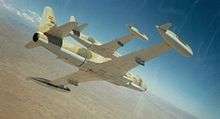
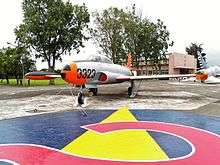

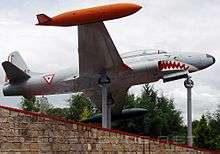
.jpg)
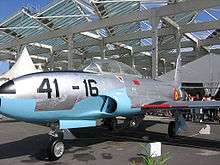
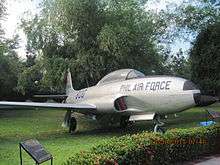
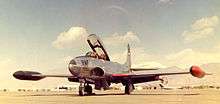

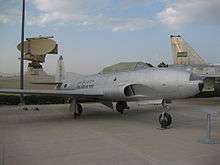
For operators of Canadian-built aircraft refer to Canadair T-33.
- Belgian Air Force (38 × T-33A, 1 × RT-33A operated from 1952) (all retired)
- Bolivian Air Force - Bolivia acquired 15 T-33AN from Canada in 1973–74, purchasing 5 more from Canada in 1977 and 18 T-33SFs from France in 1985.[7] 18 were upgraded to T-33-2000 standard in 2000–2001.[8] 14 remain operational as of December 2015.[9]
- Brazilian Air Force (all retired)
- Burmese Air Force – 15 x AT-33A for use as trainers and close air support.[10] (all retired)
 Chile (all retired)
Chile (all retired) Republic of China
Republic of China
- Republic of China Air Force (all retired)
- Colombian Air Force (all retired)
- Cuban Air Force (all retired)
- Royal Danish Air Force(all retired)[11]
- Dominican Air Force – AT-33A (all retired)
- Ecuadorian Air Force – AT-33A (all retired)
- (all retired)
- French Air Force – 163 x T-33A and RT-33A (also 61 Canadian-built T-33AN), all retired
- German Air Force 192 x T-33A, all retired
- Hellenic Air Force – T-33A, RT-33A and Canadian-built AT-33ANs (all retired)
- Guatemalan Air Force (all retired)
- Honduran Air Force – T-33A and RT-33A (all retired)
- Indonesian Air Force – T-33A (all retired)
- Imperial Iranian Air Force
- Islamic Republic of Iran Air Force (all retired)
- Italian Air Force operated 60 Lockheed T-33A and 14 Lockheed RT-33A from 1952 until 1982[12]
 Japan (all retired)
Japan (all retired)
- Japan Air Self Defense Force T-33A – assembled and later manufactured by Kawasaki Heavy Industries Aerospace Company from 1956.[13] (all retired)
- Libyan Arab Air Force – T-33A (all retired)
- Mexican Air Force – 50 units AT-33A (all retired)
- Royal Netherlands Air Force – 60 x T-33A, 3 x RT-33A, all retired
- Fuerza Aérea de Nicaragua FAN received delivery of four AT-33A aircraft from the US Government after the failed Bay of Pigs invasion in 1961. Retired from service in 1979.
- Royal Norwegian Air Force (all retired)
- Pakistan Air Force – T-33A, RT-33A (all retired)
- Paraguayan Air Force operated six AT-33A donated by Taiwan in 1990. The belonged to the Grupo Aerotáctico (GAT) 2nd. Fighter Squadron called "Indios". They were withdrawn from use in 1998.
- Peruvian Air Force (all retired)
- Philippine Air Force (all retired)
- Portuguese Air Force T-33A and one RT-33A (all retired)
- Royal Saudi Air Force (all retired)
- Republic of Singapore Air Force: 12 x Former French Air Force T-33A delivered in 1980, followed by 8 more in 1982.[14] (all retired)
- Republic of Korea Air Force: T-33A is First introduction Time: August, 1955. It also served with the ROKAF Black Eagles aerobatic team, (all retired)
- Spanish Air Force – 60 x T-33A (all retired)
- Royal Thai Air Force (all retired)
- Turkish Air Force – T-33A and RT-33A (all retired)
- Boeing Commercial Airplanes (two Canadair T-33s, N109X and N416X)[15]
- United States Air Force (all retired)
- United States Navy (all retired)
- United States Marine Corps (all retired)[4]
- Uruguayan Air Force – 8 x AT-33A[16] (all retired)
- Yugoslav Air Force – Operated 125 Shooting Stars in four variants: 25 T-33A, 22 RT-33A, 70 TV-2 and 8 TT-33A (all retired)[17]
Aircraft on display
Numerous T-33s have been preserved as museum and commemorative displays.
Notable accidents and incidents
While the cause is uncertain, a T-33 crashed near Allenspark, Colorado on July 27, 1965 while flying low and slow near a thunderstorm to check out newly purchased land. Both occupants, USAF Major Jay. E. Currie and USAF 1st Lt Donald Darby, were killed.[18][19]
Specifications (T-33A)
Data from Lockheed Aircraft since 1913[20]
General characteristics
- Crew: Two
- Length: 37 ft 9 in (11.51 m)
- Wingspan: 38 ft 10 1⁄2 in (11.85 m)
- Height: 11 ft 8 in (3.55 m)
- Wing area: 234.8 sq ft (21.81 m2)
- Empty weight: 8,365 lb (3,794 kg)
- Loaded weight: 12,071 lb (5,475 kg)
- Max. takeoff weight: 15,061 lb (6,832 kg)
- Powerplant: 1 × Allison J33-A-35 centrifugal compressor turbojet, 5,400 lbf (water injection), 4,600 lbf continuous (24.0 kN)
Performance
- Maximum speed: 600 mph (521 knots, 965 km/h) at sea level
- Cruise speed: 455 mph (396 knots, 732 km/h)
- Range: 1,275 mi (1,110 nmi, 2,050 km)
- Service ceiling: 48,000 ft (14,630 m)
- Rate of climb: 4,870 ft/min (24.7 m/s)
Armament
- Hardpoints: 2 with a capacity of 2,000 lb (907 kg) of bombs or rockets (AT-33)
See also
- Related development
- Boeing Skyfox
- Canadair CT-133 Silver Star
- Lockheed F-94 Starfire
- Lockheed P-80 Shooting Star
- Lockheed T2V/T-1A Seastar
- Aircraft of comparable role, configuration and era
- Related lists
References
Notes
- ↑ Lockheed P-80/F-80
- ↑ "787 First Flight from the chase plane." wired.com. Retrieved: 22 April 2010.
- ↑ Freeze, Di. "Michael Dorn: A Trek worth Remembering". Airportjournals.com. Airport Journals. Retrieved June 13, 2015.
- 1 2 Jansen, Clay. " US Marine Corps Lockheed T-33 Shooting Star." Cloud 9 Photography, October 1961. Retrieved: 6 August 2013.
- ↑ Beck, Simon. "Lockheed Shooting Star Series." US Warplanes.net. Retrieved: 21 October 2011.
- ↑ Gaillard, Pierre (1991). Les Avions Francaisde 1965 a 1990. Paris: Editions EPA. ISBN 2 85120 392 4.
- ↑ Siegrist 1987, p. 175.
- ↑ International Air Power Review Summer 2001, p. 28.
- ↑ Hoyle Flight International 8–14 December 2015, p. 33.
- ↑ Andrade 1982, p. 35
- ↑ Schrøder, Hans (1991). Royal Danish Airforce. Ed. Kay S. Nielsen. Tøjhusmuseet, 1991, p. 1–64. ISBN 87-89022-24-6.
- ↑ "Il portale dell'Aeronautica Militare – Lockheed RT-33". aeronautica.difesa.it. Retrieved 23 December 2014.
- ↑ "History of the Kawasaki Aerospace Division." Kawasaki Heavy Industries, Ltd. Retrieved: 21 March 2010.
- ↑ Pocock 1986, p. 92.
- ↑ "Aircraft Enquiry: N109X." FAA Registry. Retrieved: 11 Mar 2012.
- ↑ Andrade 1982, p. 336
- ↑ "Letelice Lockheed T-33A, RT-33A i TV-2 u JRV i njihove sudbine". paluba.info. Retrieved 23 December 2014.
- ↑ http://coloradowreckchasing.com/AllensparkT33/T-33.htm
- ↑ http://www.traildamage.com/trails/index.php?id=174
- ↑ Francillon 1982, pp. 287, 293.
Bibliography
- Baugher, Joe. "Lockheed P-80/F-80." USAF Fighters. Retrieved: 11 June 2011.
- Davis, Larry. P-80 Shooting Star. T-33/F-94 in action. Carrollton, Texas: Squadron/Signal Publications, 1980. ISBN 0-89747-099-0.
- Dorr, Robert F. "P-80 Shooting Star Variants". Wings of Fame Vol. 11. London: Aerospace Publishing Ltd., 1998. ISBN 1-86184-017-9.
- Francillon, René J. Lockheed Aircraft since 1913. London: Putnam, 1982. ISBN 0-370-30329-6.
- "Fuerza Aérea Boliviana". International Air Power Review. Volume 1, Summer 2001. pp. 28–31. ISSN 1473-9917.
- Gaillard, Pierre (1991). Les Avions Français 1965 a 1990. Paris: Editions EPA. ISBN 2 85120 392 4.
- Hiltermann, Gijs. Lockheed T-33 (Vliegend in Nederland 3) (in Dutch). Eindhoven, Netherlands: Flash Aviation, 1988. ISBN 978-90-71553-04-2.
- Hoyle, Craig. "World Air Forces 2015". Flight International, 8–14 December 2015, Vol. 188, No. 5517. pp. 26–53. ISSN 0015-3710.
- Pace, Steve. Lockheed Skunk Works. St. Paul, Minnesota: Motorbooks International, 1992. ISBN 0-87938-632-0.
- Pocock, Chris. "Singapore Sting". Air International, Vol. 31, No. 2. pp. 59–64, 90–92.
- Siegrist, Martin. "Bolivian Air Power — Seventy Years On". Air International, Vol. 33, No. 4, October 1987. pp. 170–176, 194. ISSN 0306-5634.
External links
| Wikimedia Commons has media related to T-33 Shooting Star. |
- T-33 in Mexican Air Force
- AeroWeb: T-33s on display list
- Warbird Alley: T-33 page
- Walkaround T-33 Shooting Star (Eskishehir, Turkey)
- Pictures of the T-33 at Oak Meadow Park, (Los Gatos, CA)
- Brief T-33 History on Air Mobility Command Museum Site with photo of display T-33 at Dover AFB, DE